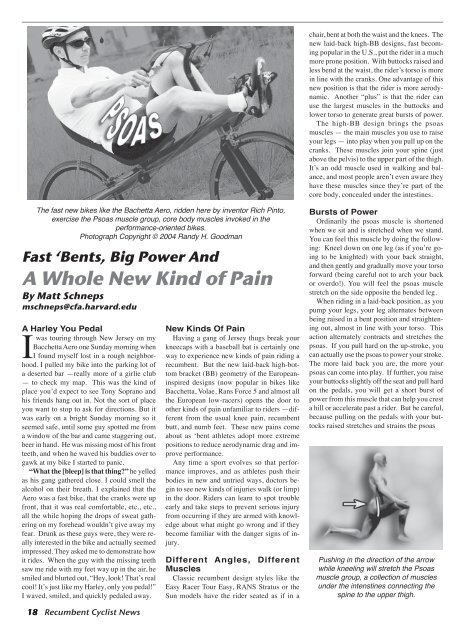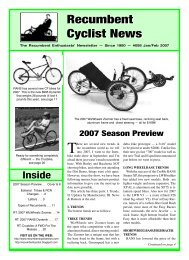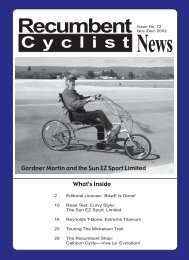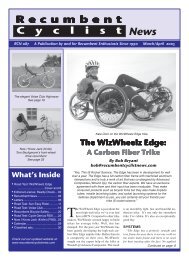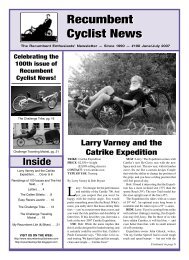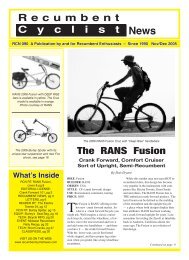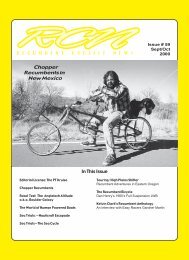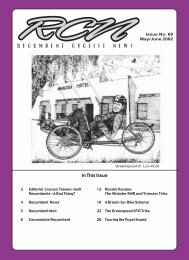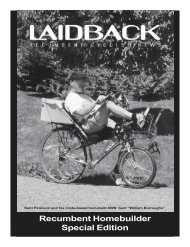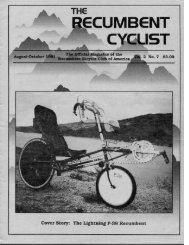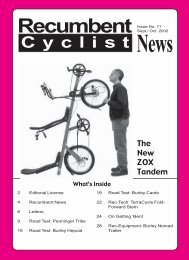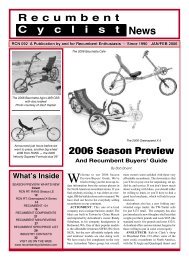C y c l i s t Recumbent - Steve Briggs
C y c l i s t Recumbent - Steve Briggs
C y c l i s t Recumbent - Steve Briggs
Create successful ePaper yourself
Turn your PDF publications into a flip-book with our unique Google optimized e-Paper software.
chair, bent at both the waist and the knees. The<br />
new laid-back high-BB designs, fast becoming<br />
popular in the U.S., put the rider in a much<br />
more prone position. With buttocks raised and<br />
less bend at the waist, the rider’s torso is more<br />
in line with the cranks. One advantage of this<br />
new position is that the rider is more aerodynamic.<br />
Another “plus” is that the rider can<br />
use the largest muscles in the buttocks and<br />
lower torso to generate great bursts of power.<br />
The high-BB design brings the psoas<br />
muscles — the main muscles you use to raise<br />
your legs — into play when you pull up on the<br />
cranks. These muscles join your spine (just<br />
above the pelvis) to the upper part of the thigh.<br />
It’s an odd muscle used in walking and balance,<br />
and most people aren’t even aware they<br />
have these muscles since they’re part of the<br />
core body, concealed under the intestines.<br />
The fast new bikes like the Bachetta Aero, ridden here by inventor Rich Pinto,<br />
exercise the Psoas muscle group, core body muscles invoked in the<br />
performance-oriented bikes.<br />
Photograph Copyright © 2004 Randy H. Goodman<br />
Fast ‘Bents, Big Power And<br />
A Whole New Kind of Pain<br />
By Matt Schneps<br />
mschneps@cfa.harvard.edu<br />
A Harley You Pedal<br />
Iwas touring through New Jersey on my<br />
Bacchetta Aero one Sunday morning when<br />
I found myself lost in a rough neighborhood.<br />
I pulled my bike into the parking lot of<br />
a deserted bar —really more of a girlie club<br />
— to check my map. This was the kind of<br />
place you’d expect to see Tony Soprano and<br />
his friends hang out in. Not the sort of place<br />
you want to stop to ask for directions. But it<br />
was early on a bright Sunday morning so it<br />
seemed safe, until some guy spotted me from<br />
a window of the bar and came staggering out,<br />
beer in hand. He was missing most of his front<br />
teeth, and when he waved his buddies over to<br />
gawk at my bike I started to panic.<br />
“What the [bleep] is that thing?” he yelled<br />
as his gang gathered close. I could smell the<br />
alcohol on their breath. I explained that the<br />
Aero was a fast bike, that the cranks were up<br />
front, that it was real comfortable, etc., etc.,<br />
all the while hoping the drops of sweat gathering<br />
on my forehead wouldn’t give away my<br />
fear. Drunk as these guys were, they were really<br />
interested in the bike and actually seemed<br />
impressed. They asked me to demonstrate how<br />
it rides. When the guy with the missing teeth<br />
saw me ride with my feet way up in the air, he<br />
smiled and blurted out, “Hey, look! That’s real<br />
cool! It’s just like my Harley, only you pedal!”<br />
I waved, smiled, and quickly pedaled away.<br />
New Kinds Of Pain<br />
Having a gang of Jersey thugs break your<br />
kneecaps with a baseball bat is certainly one<br />
way to experience new kinds of pain riding a<br />
recumbent. But the new laid-back high-bottom<br />
bracket (BB) geometry of the Europeaninspired<br />
designs (now popular in bikes like<br />
Bacchetta, Volae, Rans Force 5 and almost all<br />
the European low-racers) opens the door to<br />
other kinds of pain unfamiliar to riders —different<br />
from the usual knee pain, recumbent<br />
butt, and numb feet. These new pains come<br />
about as ‘bent athletes adopt more extreme<br />
positions to reduce aerodynamic drag and improve<br />
performance.<br />
Any time a sport evolves so that performance<br />
improves, and as athletes push their<br />
bodies in new and untried ways, doctors begin<br />
to see new kinds of injuries walk (or limp)<br />
in the door. Riders can learn to spot trouble<br />
early and take steps to prevent serious injury<br />
from occurring if they are armed with knowledge<br />
about what might go wrong and if they<br />
become familiar with the danger signs of injury.<br />
Different Angles, Different<br />
Muscles<br />
Classic recumbent design styles like the<br />
Easy Racer Tour Easy, RANS Stratus or the<br />
Sun models have the rider seated as if in a<br />
Bursts of Power<br />
Ordinarily the psoas muscle is shortened<br />
when we sit and is stretched when we stand.<br />
You can feel this muscle by doing the following:<br />
Kneel down on one leg (as if you’re going<br />
to be knighted) with your back straight,<br />
and then gently and gradually move your torso<br />
forward (being careful not to arch your back<br />
or overdo!). You will feel the psoas muscle<br />
stretch on the side opposite the bended leg.<br />
When riding in a laid-back position, as you<br />
pump your legs, your leg alternates between<br />
being raised in a bent position and straightening<br />
out, almost in line with your torso. This<br />
action alternately contracts and stretches the<br />
psoas. If you pull hard on the up-stroke, you<br />
can actually use the psoas to power your stroke.<br />
The more laid back you are, the more your<br />
psoas can come into play. If further, you raise<br />
your buttocks slightly off the seat and pull hard<br />
on the pedals, you will get a short burst of<br />
power from this muscle that can help you crest<br />
a hill or accelerate past a rider. But be careful,<br />
because pulling on the pedals with your buttocks<br />
raised stretches and strains the psoas<br />
Pushing in the direction of the arrow<br />
while kneeling will stretch the Psoas<br />
muscle group, a collection of muscles<br />
under the intenstines connecting the<br />
spine to the upper thigh.<br />
18 <strong>Recumbent</strong> Cyclist News


